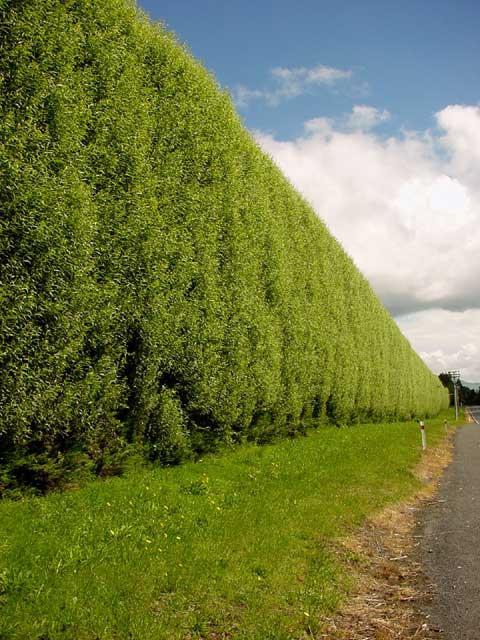Unfortunately, hedges from various plant species in the CIS countries are not as popular as in Europe. But such landings protect the infield from dust and street noise.
Hedgerow can be grown from various types of plants, but the most durable are those that consist of cotoneaster, dog rose, chokeberry, sea buckthorn, and hawthorn. All these shrubs tolerate pruning, which makes it possible to form hedges of any shape and size. Another big advantage of using such plants is that they perform not only an aesthetic function, but will also bring tasty and healthy berries. Since birds like to nest in these plants, your site will be reliably protected by them from various pests.
Hedgerow plays its decorative and protective role only if it is properly organized and well maintained. Such
plantings of shrubs and trees are multifunctional and very diverse. A hedge can be one-, two- and three-row, forming and not forming, grown from spiny or spiny plants.
Thorny plants in the planting reliably protect the site from the penetration of strangers and various animals. For such hedges, both deciduous and coniferous species are used, which can be deciduous or evergreen. Plants are chosen based on several rules: for hedges, plants with small foliage, rapid shoot growth are needed; the height of adult plants should be equal to the height of the hedge. You should not use plant species that are prone to intensive formation of basal shoots, since in this case this is a negative property. As a rule,
beautifully flowering shrubs are used for uncuttable hedges, since the overwhelming majority of flower-bearing shoots will be removed when cutting. When choosing plants should be guided by their resistance to local climatic conditions.
DIY hedges can be of different heights. So, trellises above 2 m are considered to be high plantings, medium ones that are 1-2 m high, and the lowest borders reach 0.5-1 m. Trellises are planted around the perimeter of the site and very rarely inside it. They are two-and three-row. In such plantings, pyramidal-shaped arborvitae and junipers, which do not require regular haircuts, look great, as they themselves are in excellent shape. For trellis, spruce,
cedar, pine, larch, yew, and thuja are also used. The disadvantage of such hedges is the continued growth of these plants. In this case, a full-fledged hedge will turn out only after a few years.
Along with conifers, birch, willow, poplar, hornbeam, beech, elm, maple, linden, chestnut, mountain ash, and viburnum are used for tall trellises. Medium-sized hedges are created from barberry, honeysuckle, irgi, spirea, hydrangea, junipers, mahonia, lilac, dog rose, hawthorn, blackberry, barberry, and blackthorn. Low-growing plantations are made from mock up, boxwood, almonds, magonia holly, raspberries, currants, felt cherries, stunted spirea, common barberry, gooseberries, roses.

A hedge is formed using regular pruning, during which it is given the selected shape. In the early years, pruning is done 3-4 times a year, and then - once every 6 months. Before planting, stakes and ropes mark lines of planting. They dig a trench 0.5 m wide and deep into which selected plants are planted. The number of trenches depends on the number of rows in the hedge. Planting is carried out taking into account the rules for planting specific types of shrubs and trees. The surface of the soil on which the plants are planted must be covered with ground cover materials in order to avoid its drying, weathering and freezing.
A hedge of hawthorn can be created even by an inexperienced gardener. This plant is beautiful throughout the growing season. All its types and varieties are very decorative and give delicious, healing berries. They are suitable for creating a thick, impenetrable fence. Young plants (3-4 years) are planted in trenches in the spring. The distance between them is 0.5-1 m. First, the plants are watered once a week, and after rooting, once every 2 weeks. A hedge is formed by regular pruning. Hawthorn is resistant to pests, diseases, drought and frost.